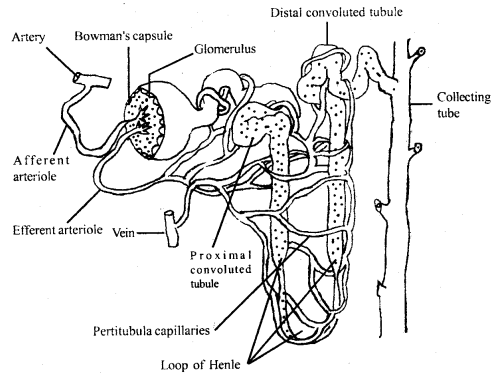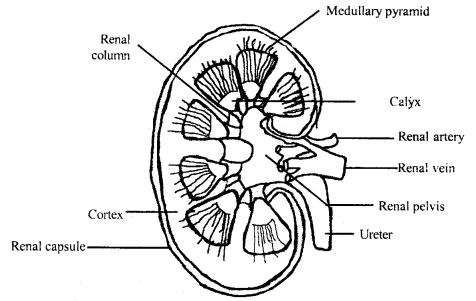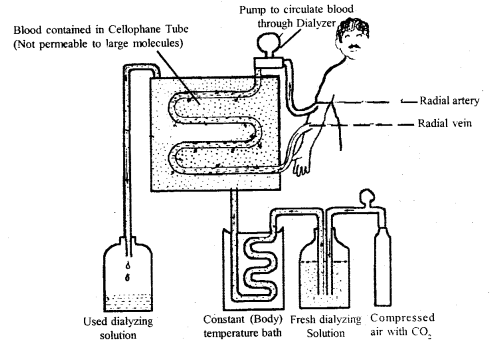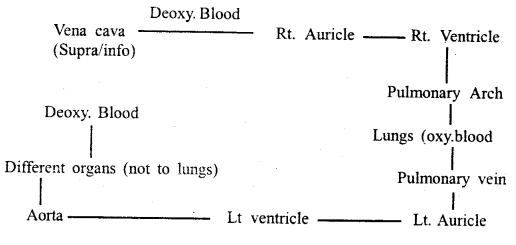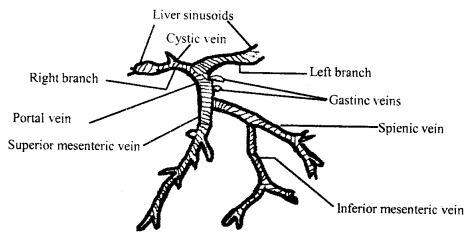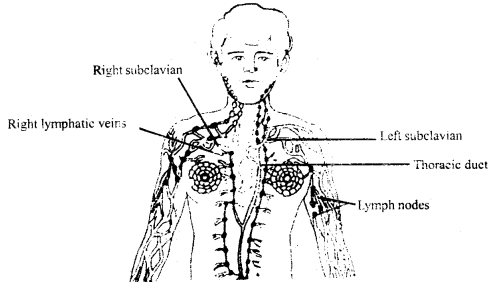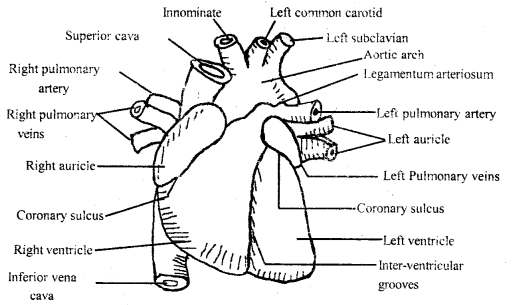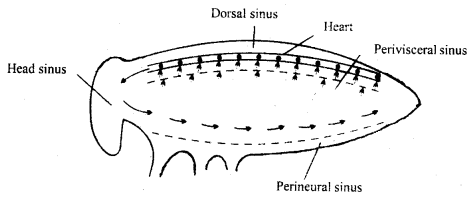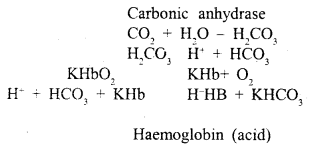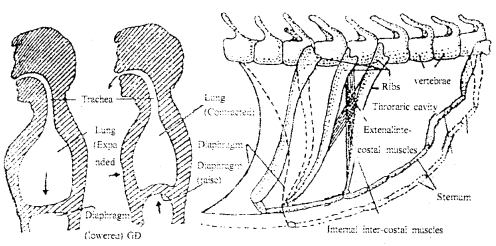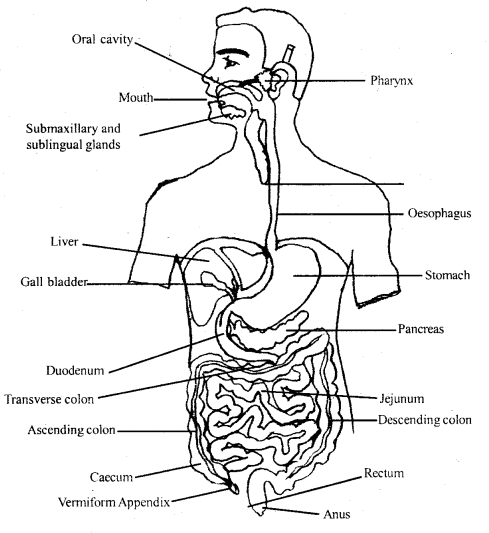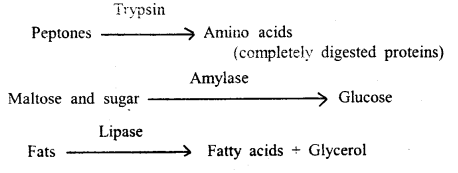Here we are providing Class 11 Biology Important Extra Questions and Answers Chapter 20 Locomotion and Movement. Important Questions for Class 11 Biology are the best resource for students which helps in Class 11 board exams.
Class 11 Biology Chapter 20 Important Extra Questions Locomotion and Movement
Locomotion and Movement Important Extra Questions Very Short Answer Type
Question 1.
What is a tendon?
Answer:
The dense connective tissue joins bone and skeletal muscle.
Question 2.
What are antagonistic muscles?
Answer:
The. pair of muscles which at a joint produce opposite movements.
Question 3.
What is tetanus?
Answer:
The continued state of muscular contraction is called tetanus.
Question 4.
What is threshold stimulus?
Answer:
The stimulus of minimum strength which is required to bring about muscular contraction is called the threshold stimulus.
Question 5.
What is a muscle twitch?
Answer:
The single contraction of muscle upon receiving the stimulus is called muscle twitch. (Contraction is followed by relaxation).
Question 6.
What is sarcomere?
Answer:
The functional unit of myofibril contracts and causes the shortening of muscle fibre.
Question 7.
How many bones are present in the human skeleton?
Answer:
The human skeleton contains 206 bones.
Question 8.
What are synovial joints?
Answer:
These are freely movable joints due to the presence of synovial fluid in the synovial cavity.
Question 9.
What is locomotion?
Answer:
The bodily movement in animals from one place to the other is called locomotion.
Question 10.
What is rigour mortis?
Answer:
Stiffening of muscle after death.
Question 11.
Name the proteins which help in muscle contraction.
Answer:
Myosin and actin.
Question 12.
What is the function of synovial fluid?
Answer:
Synovial fluid acts as a lubricant.
Question 13.
What is a pivot joint?
Answer:
The joint allows the turning or rotational movements, e.g., between atlas and axis vertebra.
Question 14.
Which of the movable joint makes the hip joint?
Answer:
Ball and socket joint.
Question 15.
Which muscle contracts to make your palm face upwards?
Answer:
Supinator.
Question 16.
How many bones are there in the human skull?
Answer:
29
Question 17.
Which type of movable joint is the knee joint?
Answer:
Hinge joint.
Question 18.
Name the band of the skeletal joint which permits movements in a single plane only.
Answer:
Hinge joint.
Question 19.
Differentiate between A-band and I-band.
Answer:
- A-band is a dark band having myosin filaments.
- I-band is a light band having thin filaments.
Question 20.
What is the total number of bones in our body?
Answer:
206.
Question 21.
Name the five different categories of vertebrae in your backbone.
Answer:
- Cervical,
- thoracic,
- lumber,
- sacral and
- coccygeal.
Question 20.
Where inside the bones are blood cells produced?
Answer:
The bone marrow of long bones.
Question 23.
Give one example of a ball and socket joint.
Answer:
Shoulder joint.
Locomotion and Movement Important Extra Questions Short Answer Type
Question 1.
List the mechanical function of the skeleton.
Answer:
- It provides a rigid framework of the body and definite shape to organs.
- It supports the weight of the body.
- It protects the internal organs.
- Its long bones function as a lever.
- Skeletal muscles with flexible connective tissue bands called tendons in association with endoskeleton and joints give locomotion and movements to different body parts.
Question 2.
List some biological function of the skeleton.
Answer:
- Provides attachment surface to muscles.
- Serves as storage depot of calcium and phosphate minerals.
- Act in erythropoiesis.
- Ear ossicles help in sound wave propagation.
- Redbone marrow present inside the marrow cavity of long bones such as femur, humerus and in interstices of spongy bones of vertebrae, sternum, scapula etc. help in the formation of RBCs, WBCs and platelets of the blood. This process is known as Haemopoiesis.
Question 3.
List different modes of locomotion and movement in hydra.
Answer:
- Contraction and expansion
- Bending and swaying
- Looping
- Somersaulting.
- Floating
- Gliding
- Swimming
- Walking.
Question 4.
What are the different molecules present in muscles?
Answer:
- Contractile proteins viz. actin, myosin and tropomyosin.
- Enzymes and other proteins like troponin.
- Carbohydrate as a substrate for energy.
- Energy carries viz. ATP, ADP, AMP and CP.
- Ions viz. Na+, K+, Mg++, Ca+, CI+.
Question 5.
Differentiate between isotonic and isometric contraction
Answer:
| Isotonic contraction | Isometric contraction |
| 1. There is a change in the shape of muscles. | 1. There is no change in the shape of muscles |
| 2. Muscles maintains tension. | 2. Muscles maintains length. |
| 3. Muscles contracts and the load is lifted | 3. Muscles contracts against a load that can’t be lifted. |
Question 6.
A red muscles fibre works for a prolonged period, whereas a white muscle fibre gets fatigued, why?
Answer:
Red muscle fibres contain oxygen storing pigment myoglobin and a large number of mitochondria, so they can have O2 supply for aerobic respiration and release of energy for a longer period.
White muscles fibres do not have myoglobin pigment. They face a short supply of O2 and much depends on anaerobic respiration, so they get fatigued soon.
Question 7.
What are the main types of joints present in the human body?
Answer:
The types of joints present in the body of man are:
1. Fixed or fibrous joints: There is no movement at all in articulating joints, because of the presence of tough, inextensible, white fibrous tissue, e.g., skull bones.
2. Slightly movable or cartilaginous joints: A limited movement is possible in articulating bones. A dense disc of white cartilage joins the articulating surfaces, e.g., vertebrae and public symphysis.
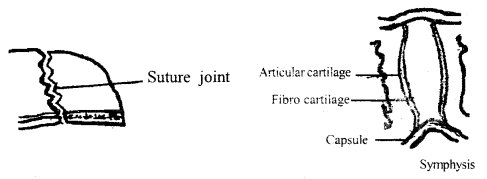
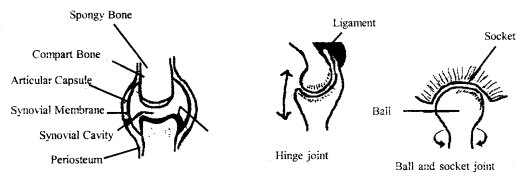
Different types of joints
3. Freely movable or synovial joints: Free movement is possible due to the presence of synovial fluid in the synovial cavity, between the articulating bones, e.g., hinge joint, ball and socket joint.
Question 8.
What are the advantages of the movement of body parts?
Answer:
The movement has the following advantages:
- With change in body posture and limb movement, equilibrium of the body is maintained.
- Limb movement causes locomotion.
- Food is captured by movement of tentacles, limbs, jaw, tongue etc. in different animals.
- Changes in environment surrounding can be sensed by the movement of the eyeball, pinna etc.
- Blood circulation is possible by heart movement.
- Movement of the diaphragm causes inhales and exhale (breathing).
Question 9.
What are the advantages of locomotion?
Answer:
The bodily movements or locomotion has the following advantages:
- It enables the body to shift it entirely from one place to the other.
- It protects the organism from predation.
- It helps the animals to make the search for their food and other nutritional requirements.
- It helps the animal to seek a mate for reproduction.
Question 10.
Draw a labelled diagram of the joint found between the pelvic girdle and femur. Also, write the type of this joint.
Answer:
Type of the joint: The joint between pelvic and femur bones is a ball and socket synovial joint.
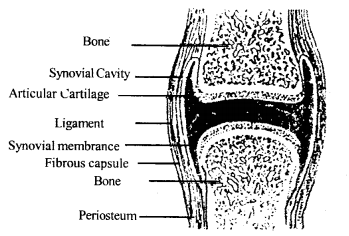
Synovial ball and socket joint between pelvic and femur
Question 11.
Why movement and locomotion are necessary among animals?
Answer:
Movement and locomotion are necessary among animals for the survival of them. It enables, them to procure food, search for shelter, find mates, protect themselves from predatory and perform many other life activities.
Question 12.
Elucidate the types of movements found among the animals.
Answer:
Movements among animals vary greatly. Movement involves three basic mechanisms.
These are:
- amoeboid,
- ciliary and
- muscular.
Amoeboid movement is typical of Amoeba. Amoeba moves with the help of pseudopodia. Amoeboid movement helps in the food capture and change of place as well.
The same method of movement is also employed by the leucocytes, like phagocytes and macrophages of the human lymphatic system for engulfment of antigen and migration of circulatory fluid. In protozoan ciliary movement is seen. Muscular movement is the basic mechanism used in the majority of vertebrates including humans. Most multicellular animals possess muscle fibres for the movement of different organs and at¬taining locomotion.
Question 13.
What is muscle? Write the names of different types of muscles?
Answer:
Locomotion in humans depends on the movements of muscle fibres (muscle cells). Muscles are made up of contractile fibres which in turn formed of myofibrils. In humans, muscles constitute nearly 40 – 50 per cent of the total body weight.
Muscles are broadly classified into three categories.
- Skeletal muscles: These are attached to the bones by tendons and help in the movement of the part of the skeleton. These muscles are under the control of the conscious mind and can be moved to the wall.
Skeletal muscles are termed voluntary muscles. - Cardiac muscles: These are also striated and occur exclusively on the heart.
- Smooth muscles: These are involuntary and non-striated muscles and are innervated by the autonomic nervous system.
Question 14.
How the skeletal muscle contracts?
Answer:
During contraction, the actin and myosin filaments slide past each other to reduce the length of the sarcomeres. The actin filaments move inwards towards the centre of the sarcomere. The heads of the myosin filaments operate as ‘hooks’, attaching to the F-actin they form cross-bridges, then change their relative configuration and pull the actin filaments.
As 3 result, the Z-lines limiting the sarcomeres are drawn closer together, but the length of A-bands remain unchanged. The I-bands reduce in length.
However, the net result is the shortening of the sarcomere. The actin filament slides out from the A-band resulting in the lengthening of the sarcomere.
Question 15.
What is arthritis? How is it caused?
Answer:
It is a disorder of bones in which fibrous tissues are attached with bones- and become ossified, making the joints immovable.
It is caused by the inflammation of the joints. It is of several types, e.g., rheumatoid arthritis, osteoarthritis ‘and gouty arthritis.
Question 16.
Write the names of the factors which are responsible for osteoporosis.
Answer:
Imbalances of hormones like thyrocalcitonin, parathyroid and sex hormones, deficiencies of calcium and vitamin D are the major Causativetors.
Question 17.
How do the joints help in the movement? Explain.
Answer:
A synovial or movable joint is a joint which allows the movement of collating bones such that they can move extensively upon each other. In joints, there is a space called a synovial cavity. This cavity remains filled in a fluid called synovial fluid.
The movement of an organ occurs due to the pulling of bones. Movement takes place along the joints which act as the fulcrum of the liver. In fact, the joints function as a lever. Due to the presence of a number of joints movement of the different body parts and the whole body is possible.
Question 18.
How calcium affects the process of muscle contraction?
Answer:
Muscle fibres are excitable. Normally, a nerve impulse arriving at the neuromuscular junction initiates a contractile response. A neurotransmitter released at the neuromuscular junction enters into the sarcomere through its membrane channel. The opening of the channel also results in the inflow of Na+ inside the sarcomere and generates an action potential in the muscle fibre.
The sarcoplasmic reticulum releases the stored Ca++, which binds with the specific sites present on the troponin component of the thin filament. As a result, the active sites present on the F-actin molecules are exposed. These sites are specific to the myosin head, which exhibits Mg++ dependent ATP as activity.
During relaxation of the muscle, the Ca++ is pumped back into the sarcoplasmic reticulum. As a result, the troponin component becomes free. The cross-bridge breaks and the thin filament occupies its normal position. The muscle relaxes.
Question 19.
Write the difference between movable and immovable joints.
Answer:
| Movable joints | Immovable joints |
| 1. The articulating surfaces are kept in close contact by a fibrous capsule and a slippery synovial fluid occurs in the space between the articulating surfaces of the bone. | 1. The articulating bones at this joint are firmly held together by dense bands of tough inextensible white fibrous tissue. |
| 2. It permits considerable movement of the articulating bones. | 2. It does not permit any movement of the articulating bones. |
Question 20.
Fill in the blanks:
Answer:
- Troponin is a part of Myosin filament.
- The Head of the myosin has AT passive activity.
- Humerus Radius and Ulna bones are found in the forearm.
- The acetabulum is present in the Pelvic girdle.
- The ball and socket joint is a Movable girdle.
Question 21.
Match column I with column II
| Column I | Column- II |
| (a) Smooth muscle | (i) Myoglobin |
| (b) Tropomyosin | (ii) Third class lever |
| (c) Red muscle | (iii) Thin filament |
| (d) Skull | (iv) Sutures |
| (e) Forearm | (v) Involuntary |
Answer:
| Column I | Column- II |
| (a) Smooth muscle | (v) Involuntary |
| (b) Tropomyosin | (iii) Thin filament |
| (c) Red muscle | (i) Myoglobin |
| (d) Skull | (iv) Sutures |
| (e) Forearm | (ii) Third class lever |
Question 22.
What is a joint? Write its type with an example.
Answer:
Joints are the place of articulation between two or more bones or between a bone and cartilage. Due to the presence of a number of joints, the movement of the different body parts and the whole body is possible.
There are three types of joints:
- Fixed or immovable joints: There is no space between the bones. They are attached very tightly with the help of white fibrous connective tissue.
- Slightly movable or cartilaginous: It is an articulation between the bones that allow a very little movement.
- Movable joints or synovial: It is a joint which allows the movement of articulating bones such that they can move extensively upon each other. In such joints a synovial vanity is present.
Question 23.
What is the role of the girdle in the skeleton?
Answer:
Girdle bones provide a connection between the axial skeleton and limbs. The two girdles are named pectoral and pelvic girdles. Each girdle is formed of two halves.
Locomotion and Movement Important Extra Questions Long Answer Type
Question 1.
(a) During muscular contraction what are the chemical changes that take place. Describe in a listed form.
Answer:
The main chemical events that happen during muscular contraction described by Albert Szent Gyorgi are
1. Acetylcholine is released from vesicles at the neuromuscular junction. It stimulates the muscle.
2. Hydrolysis of ATP in the presence of Ca++ and Mg++ Energy used up in muscle contraction.
3. ADP is charged again by taking phosphate from creatine phosphate (CP).

4. During relaxation, creatine is phosphorylated, energy being provided by anaerobic conversion of muscle glycogen into lactic acid.
Creatine + ATP— Creating-phosphate + ADP
5. Energy released by hydrolysis of ATP causes rotation of myosin heads and bring near the actin filaments, actomyosin complex is formed, eventually, sarcomere shortens.
6. Ca++ are actively transported to the sarcoplasmic reticulum, no more Ca++ available for ATP breakdown, no further energy available for further contraction of the sarcomere.
7. Part of the energy is utilized by breaking of cross-bridges and the muscle relaxes.
(b) What are the main groups of vertebrae in the vertebral column of man?
Answer:
There are 5 groups of vertebrae namely cervical, thoracic, lumbar, sacral and coccygeal vertebral.
(The vertebral formula is C7, T12, L5, C3-5 = 32 – 34).
Question 2.
(a) What purposes does movement of external body parts in relation to body axis serve in animals?
Answer:
- The movement of limbs, appendages, head and trunk serves to change the body posture to maintain equilibrium against gravity.
- Limb movements are prerequisites for carrying out locomotion.
- Prehension of food involves movement of tongue, jaws, snout, tentacles, limbs and appendages in different animals.
- Movement of eyeballs and pinna of ear help to collect information from the external environment.
(b) What are fibrous joint and cartilaginous joints and their biological function?
Answer:
- Fibrous joint: The articulating bones are firmly held together by the dense bands of tough, inextensible white fibrous tissues. They provide strength and support for the body or protection of delicate structures which cannot withstand any kind of deformation.
- Cartilaginous joints: In cartilaginous joints, a dense disc of white fibrocartilage joins the opposing surfaces of the articulating bones to each other. This allows a limited movement at the joints.
(c) Explain Antagonistic muscles.
Answer:
Antagonistic muscles: Antagonistic muscles are those which contract to produce opposite movements at the same joint. When a muscle contract to produce a movement, its antagonistic must relax to allow that movement to take place, e.g., the bicep is a FLEXER for the elbow joint and the tricep is it’s antagonistic and an EXTENSOR for that joint.
During flexion at the elbow, the biceps contract and the tricep relax, during extension at the same joint the tricep contracts and the biceps relaxes.
(d) Distinguish between muscles twitch and tetanus or explain muscle twitch and tetanus.
Answer:
A single isolated contraction caused by a single nerve impulse or electric shock is called a muscle twitch. Immediately after the brief twitch, the muscle fibres relax.
Tetanus is a continued state of concentration caused by many repeated stimuli. Much higher tension is developed in tetanus than in an isolated twitch. Almost all our daily activities are carried out by tetanic contractions of muscles.
Question 3.
How thick and thin filaments are arranged in a muscle fibre?
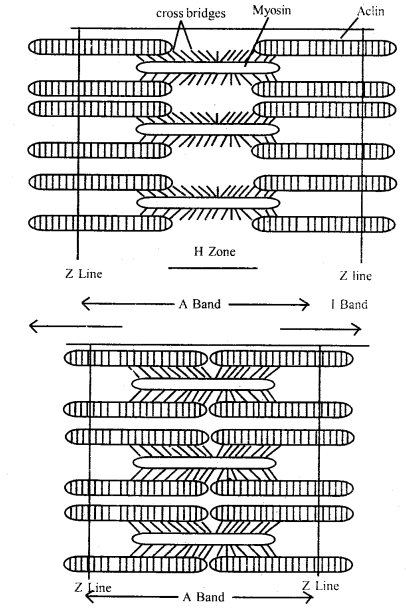
relationship between actin and myosin filaments in stretched and contracted states
Answer:
Each striated muscle contains thin actin and thick myosin filaments. These filaments are longitudinally arranged inside light I bands and dark A bands respectively. The actin and myosin filaments remain cross-linked with each other in the myofibril. Sarcomeres are the rows of functional unit in each myofibril, each extending from the dark Z- line of the next I band. Each sarcomere thus comprises of A band in the middle with 2 half I band on its two sides.
From each Z line, the actin filaments through half of the I band intermingles with the ends of myosin filaments in the A band. The myofibril is surrounded at each I band by the tubules and cisternae of sarcoplasmic reticulum and at each junction of A and I bands by a TI tubule communicating with the cell exterior, which is shown in the figure. The relationship between actin (thin filament) and myosin (thick filament).
